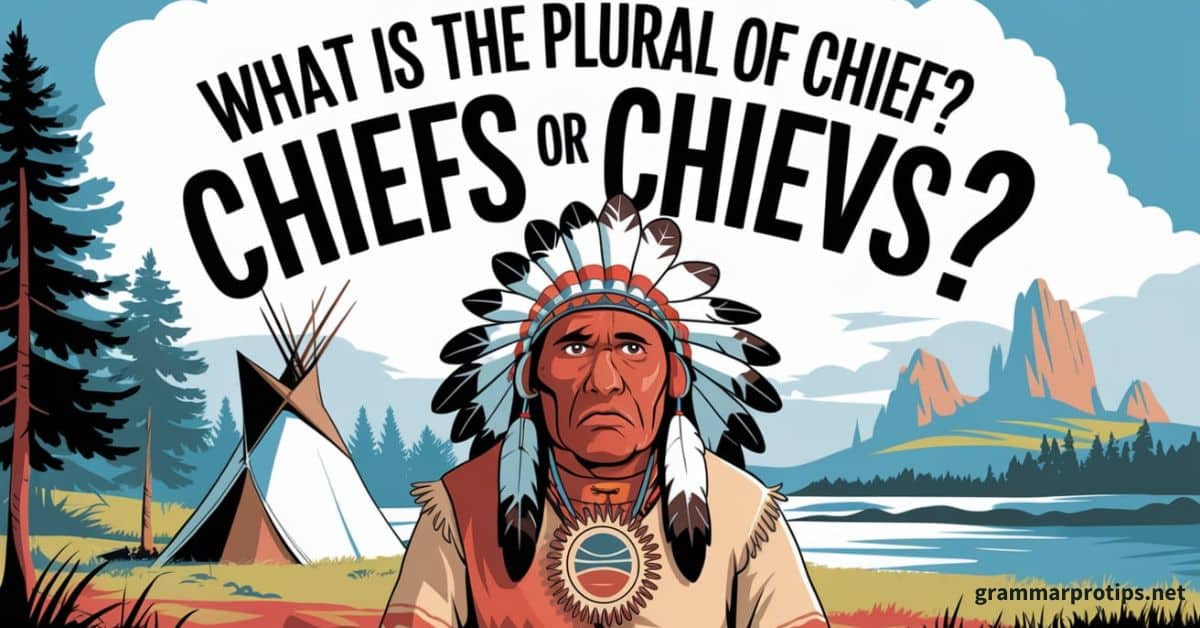When we talk about plural forms in English, things can get a little tricky. While many rules are straightforward, others require a bit of nuance, especially when it comes to words with irregular endings or those that stem from other languages. One such word that often raises questions is chief. You may have wondered: What is the plural of chief? Is it chiefs or chieves?
Let’s take a deep dive into this common query, explore its historical background, and provide some real-world examples to help clear up any confusion.
Understanding the Plural of Chief
First, let’s answer the fundamental question. The plural of chief is chiefs.
Chiefs follows the regular pattern for pluralization in English where a word ends in -f or -fe. In this case, you simply add -s to make it plural.
Although this is the standard rule, you may notice that there are exceptions, especially with words like “knife” (plural: knives) and “leaf” (plural: leaves). But for chief, you just add the -s.
Chieves, on the other hand, is incorrect and doesn’t exist in modern English.
Why Is the Plural of Chief Chiefs and Not Chieves?
One common point of confusion is why is the plural of chief chiefs and not chieves? It’s because the word chief is a regular noun in terms of pluralization, despite the fact that it ends in -f.
Historically, some words ending in -f did indeed form their plural by changing the -f to a -v and adding -es, like wife becoming wives. But chief simply follows the regular rule of adding -s.
The idea of chieves might sound logical if you’re familiar with the pluralization rule for some other nouns, but for chief, that’s not how it works.
Chief Plural Examples in Sentences
Now, let’s look at some chief plural examples to show you how chiefs is used in real-life contexts.
Example 1: A Corporate Email
Let’s imagine an email between two executives, where the plural of chief comes into play.
Subject: Leadership Strategy Update
Dear Emily,
I wanted to reach out regarding the upcoming leadership conference. The chiefs of our various departments will be presenting updates on their current projects, and I think it’s important we focus on streamlining our operations moving forward.
Can you confirm the list of chiefs who will be attending, and let me know if we need to make any changes to the schedule?
Best regards,
John
In this case, chiefs refers to the multiple leaders of different departments in a company.
Example 2: Sports Scenario
Consider this email involving the chief plural in a sports context.
Subject: Pre-Game Strategy Briefing
Dear Coach Taylor,
I hope you’re well. I wanted to touch base regarding the game tomorrow. The chiefs of the opposing team’s defense have been looking at some unusual formations in the past few matches, so we need to be ready to adapt quickly.
Let’s plan for a strategy meeting after practice today to discuss the game plan.
Best,
Michael
Here, chiefs is used to refer to the lead defensive players, or even perhaps the team captains. The plural of chief works perfectly in this context.
Example 3: A Military Setting
In military communication, the term chief can refer to senior leaders. Here’s an example of how chiefs would appear in an official setting.
Subject: Weekly Leadership Briefing
General Thompson,
The chiefs of staff will be meeting tomorrow to review the current operation’s progress. We need to ensure that all chiefs are aligned on the new strategic objectives for the coming week.
Please confirm if any additional preparations are needed from our end.
Respectfully,
Lieutenant Harris
In this email, chiefs of staff is the appropriate term to indicate multiple senior officers, showcasing how the plural of chief of staff works in formal language.
Common Misunderstanding: Chieves or Chiefs?

You might still be wondering whether chieves has ever been used or why it doesn’t show up as often. The answer is simple: chieves is incorrect.
It’s a misinterpretation based on the assumption that the -f changes to a -v for plurals, like in wives. However, chiefs adheres to the common pluralization rule where no change to the -f occurs.
If you ever encounter chieves in any text, it’s likely a typographical error or a result of confusion. Stick with chiefs, and you’ll be correct every time.
Additional Pluralization Rules: Exploring Other Words
Handkerchief Plural
We already mentioned chief and its straightforward plural form. However, the word handkerchief also ends in -f, which might raise the question: What is the plural of handkerchief? The plural of handkerchief is handkerchiefs (not handkerchiefts). Here, you just add -s without altering the -f, similar to chief.
| Singular | Plural |
|---|---|
| Chief | Chiefs |
| Handkerchief | Handkerchiefs |
Dwarf Plural
English can be unpredictable. Consider the word dwarf, which also ends in -f. The plural of dwarf is dwarfs, not dwarves (although the latter can sometimes be used in certain contexts, especially in fantasy settings). But typically, dwarfs is the correct plural.
Cliff Plural
Another example is the word cliff. The plural of cliff is cliffs, not clives or any other variation. This showcases the consistency of the -f to -s pattern that we see with chief.
| Singular | Plural |
|---|---|
| Dwarf | Dwarfs |
| Cliff | Cliffs |
Cultural and Linguistic Background of “Chief”
The word chief itself has a rich etymology, rooted in the Old French chef (meaning leader or head) and further derived from the Latin caput, meaning “head.” Over time, chief has evolved to refer to a variety of positions of leadership, from tribal chiefs in indigenous cultures to corporate or military chiefs.
In many cases, the word chief is also used as a title (e.g., Chief Executive Officer, Chief of Police), which is why it is important to understand its pluralization in formal settings. Recognizing the role and context of the word helps reinforce the correct usage of its plural form, chiefs.
Summary: Chief Plural in Context
In summary, the plural of chief is chiefs, not chieves. English can be tricky with its pluralization rules, but in this case, it follows a consistent pattern: add -s to words ending in -f like chief, handkerchief, cliff, and dwarf. You can confidently use chiefs in all cases—whether in business, military, sports, or even fantasy settings!
If you’re ever unsure about a plural form, a quick check can help you confirm if it follows the regular -s rule or requires special changes like wives or knives. Keep practicing, and soon pluralizing words like chief will become second nature.
Quick Recap of Key Points:
- Chief plural = Chiefs.
- Chieves is not a valid form.
- For words ending in -f or -fe, the plural is often formed by adding -s (e.g., chiefs, handkerchiefs, cliffs).
- In English, not all -f ending words follow the same rule—words like knife and wife form their plural with -ves.
Feel free to revisit this article whenever you need a refresher. And next time you’re unsure about chief plural or any other tricky English grammar rule, you’ll have the answer at your fingertips!

Sienna Mauldon is a passionate writer and grammar expert. On her blog, she shares easy-to-follow guides to help readers master grammar rules and improve their writing. With a love for language and teaching, Sienna makes grammar simple and fun for everyone, from beginners to experienced writers.








